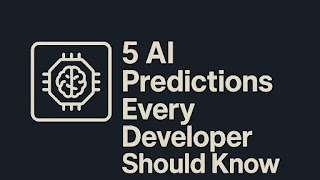Introduction
Artificial Intelligence is no longer just a buzzword — it’s a must-have in modern app development.Explore the top 5 AI APIs every developer must use in 2026 for smarter, faster, and scalable app development.
Top 5 AI APIs Every Developer Should Know About in 2026
In 2026, developers are leveraging powerful AI APIs to build smarter apps, automate complex tasks, and improve user experiences with just a few lines of code.
Whether you're building chatbots, recommendation engines, or vision-based applications, the right API can save you weeks (even months) of work.
Here are the Top 5 AI APIs every developer should master in 2026 to stay ahead of the curve.
🔍 What is an AI API?
An AI API (Application Programming Interface) is a set of pre-built functions and models you can integrate into your app to perform intelligent tasks like:
-
Text generation
-
Speech recognition
-
Image analysis
-
Natural language processing (NLP)
-
Recommendation systems
No need to build your own model from scratch — just plug in and go.
🧠 Top 5 AI APIs for Developers in 2026
1. OpenAI API (ChatGPT & GPT-5)
The most versatile AI API on the planet, powering everything from chatbots to content creation.
Key Features:
-
Natural language generation (ChatGPT, GPT-5)
-
Code completion with Codex
-
Function calling, JSON output, memory features
-
Embeddings and search capabilities
Use Cases:
-
AI assistants
-
Customer support chatbots
-
Blog and email writing
-
App logic automation
✅ Why Use It: Industry-leading language model with easy integration and strong documentation.
2. Google Cloud Vertex AI
A full-suite AI platform with scalable APIs for vision, NLP, translation, and AutoML.
Key Features:
-
Vision API: Detect objects, labels, and text in images
-
Natural Language API: Entity recognition, sentiment analysis
-
Translation API: Real-time multilingual translation
-
Generative AI Studio with PaLM models
Use Cases:
-
Image tagging
-
Language detection
-
Smart search
-
Enterprise AI workflows
✅ Why Use It: Built for scale and backed by Google’s machine learning infrastructure.
3. Microsoft Azure Cognitive Services
Azure’s collection of AI APIs is enterprise-ready and tightly integrated with Microsoft tools.
Key Features:
-
Vision, Language, Speech, and Decision APIs
-
Face recognition and verification
-
Text-to-Speech & Speech-to-Text
-
Language understanding (LUIS)
Use Cases:
-
Identity verification
-
AI-powered accessibility features
-
Multilingual support in apps
-
Secure enterprise apps
✅ Why Use It: Best for enterprises using Microsoft ecosystem (Teams, Office, Azure).
4. Stability AI API (Stable Diffusion)
Perfect for developers in gaming, media, design, and creative AI.
Key Features:
-
Image generation with Stable Diffusion
-
Fine-tuning models
-
Inpainting, outpainting
-
Text-to-image at scale
Use Cases:
-
AI art generators
-
Game asset creation
-
Marketing visuals
-
App UI generation
✅ Why Use It: Highly customizable image generation with open-source flexibility.
5. Hugging Face Inference API
A developer’s paradise with over 100,000 pre-trained AI models for every domain.
Key Features:
-
Transformers (BERT, RoBERTa, T5, etc.)
-
Text, audio, image, and tabular data models
-
On-demand inference
-
Easy integration with Python and JavaScript
Use Cases:
-
Sentiment analysis
-
Translation
-
Question answering
-
Custom model deployment
✅ Why Use It: Community-driven, research-backed models with plug-and-play API access.
📊 Summary Table: AI API Comparison
| API | Best For | Key Strength |
|---|---|---|
| OpenAI API | Language tasks, automation | ChatGPT/GPT-5 power |
| Google Vertex AI | Enterprise-scale AI solutions | Vision, NLP, AutoML |
| Azure Cognitive Services | Speech, face, enterprise apps | Deep Microsoft integration |
| Stability AI | Creative AI, image generation | Stable Diffusion flexibility |
| Hugging Face | Pretrained models for everything | Open source + vast model library |
🛠️ Bonus: Tips for Using AI APIs Like a Pro
✅ Always monitor rate limits and pricing tiers
✅ Store API responses locally when possible (caching)
✅ Use secure keys and implement rate throttling
✅ Read API changelogs — updates can break features
✅ Combine multiple APIs for powerful hybrid solutions
🔮 What's Next for AI APIs in 2026?
-
Low-latency edge APIs for mobile and IoT
-
Multimodal AI APIs (text + image + video)
-
Open-source API marketplaces for indie developers
-
Auto-adaptive APIs that learn from your app in real-time
🚀 Final Thoughts
AI APIs are the ultimate shortcut to building powerful, intelligent, and scalable apps.
In 2026, mastering these top tools will make you 10x faster, smarter, and more competitive as a developer.
Whether you're coding a game, automating workflows, or building the next viral app — these AI APIs are your new secret weapons. 🔧🧠⚡
🔁 Related Posts:
-
7 AI Tools That Will Replace Your Backend in 2026
-
How to Build a Chatbot with OpenAI’s Function Calling
-
Top Open Source AI Projects for Developers in 2026
